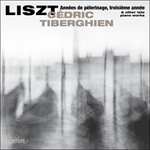
Welcome to Hyperion Records, an independent British classical label devoted to presenting high-quality recordings of music of all styles and from all periods from the twelfth century to the twenty-first.
Hyperion offers both CDs, and downloads in a number of formats. The site is also available in several languages.
Please use the dropdown buttons to set your preferred options, or use the checkbox to accept the defaults.

| Cédric Tiberghien (piano)» More |
The four remaining pieces are all elegiac: the two Cypresses are both subtitled ‘Threnody’ although no specific object of lamentation is divulged. And it is clear that Liszt wrote the second under the misapprehehsion that Michelangelo had planted the first cypress at Santa Maria degli Angeli in Rome, and that he changed the title when he discovered his error. Whilst the first of the Cypresses is nominally in G minor/major, the effect of suspended tonality is present from the beginning. There is some attempt here at depicting (in 3/4) the rocking of the trees in the wind, a feature altogether absent in the second threnody which makes an oblique nod towards the traditional funeral march without ever succumbing. The other two elegies refer to Liszt’s personal acquaintances: in a broad sense in Sunt lacrymae rerum and specifically in the Marche funèbre. The first of these, originally entitled ‘Thrénodie hongroise’ refers to the rout of the Hungarian War of Independence (1848–1849) and the subsequent execution of some of Liszt’s patriotically distinguished friends (cf the earlier Funérailles) and the final title comes from words spoken by Aeneas in Virgil’s Aeneid (quoted here in the translation by W F Jackson Knight): ‘… there is pity for a world’s distress, and a sympathy for short-lived humanity.’ The music has several overtly Hungarian characteristics, especially in the matter of augmented seconds in the melodic lines. The hapless quondam archduke who became Emperor of Mexico, mistakenly believing himself to have been popularly elected, who attempted social and economic reforms, and who was eventually executed by the man he replaced, is commemorated in a powerful lament which emerges into triumphant optimism, in line with the quotation from an elegy by Propertius (Book 2, No 10) which Liszt placed at the head of the score: ‘In magnis et voluisse sat est’ (‘To have wished for great things is an accomplishment in itself’).
from notes by Leslie Howard © 1991
Les quatre morceaux qui restent sont tous élégiaques: les deux Cyprès sont tous deux sous-titrés «Thrénodie», bien qu’aucun objet spécifique de lamentation ne soit divulgué. Et il est évident que Liszt écrivit le second morceau avec la fausse impression que Michel-Ange avait planté le premier cyprès à Santa Maria degli Angeli à Rome, et qu’il changea le titre quand il découvrit son erreur. Alors que le premier Cyprès est nominalement en sol mineur/majeur, l’effet de tonalité en suspens est présent dès le début. Il y a dans ce morceau un effort à décrire (en 3/4) le bercement des branches d’arbre sous le vent, trait qui est totalement absent dans les deuxièmes lamentations, qui penchent obliquement vers la marche funèbre traditionnelle sans jamais le devenir vraiment. Les deux autres élégies se rapportent à des connaissances personnelles de Liszt: en général dans Sunt lacrymae rerum et explicitement dans la Marche funèbre. La première de celles-ci, dont le titre était à l’origine «Thrénodie hongroise» se rapporte à la déroute de la Guerre d’Indépendance hongroise (1848–49) et les exécutions qui en résultèrent pour certains amis de Liszt remarquablement patriotes (voir Funérailles composées auparavant) et le titre final a pour source les paroles prononcées par Enée dans l’Enéïde de Virgile: «… une pitié pour la détresse du monde et une sympathie pour une humanité éphémère.» La musique fait preuve de plusieurs caractéristiques manifestement hongroises, particulièrement en ce qui concerne les secondes augmentées des lignes mélodiques. L’infortuné vieil archiduc qui devint Empereur du Mexique, faussement persuadé qu’il avait été élu par la voix populaire, qui essaya des réformes sociales et économiques et qui fut finalement exécuté par l’homme qu’il avait remplacé est commémoré par une puissante lamentation qui se transforme en optimisme triomphant, en accord avec une citation d’une élégie de Properce (Livre 2, No 10) que Liszt plaça en exergue de la partition: «In magnis et voluisse sat est» («Dans les grandes entreprises, vouloir est déjà bien»).
extrait des notes rédigées par Leslie Howard © 1991
Français: Alain Midoux
Die vier übrigen Stücke sind alle elegisch: Die beiden Cypresses tragen beide den Untertitel „Threnodie“, obwohl kein bestimmtes Objekt der Klage genannt wird. Es ist klar, daß Liszt das zweite Stück in der irrigen Annahme schrieb, Michelangelo habe die erste Zypresse in Santa Maria degli Angeli in Rom gepflanzt. Jedenfalls änderte er den Titel, als er seinen Irrtum entdeckte. Die erste der Cypresses steht dem Namen nach in g-Moll/G-Dur, doch der Effekt einer aufgehobenen Tonalität macht sich von Anfang an bemerkbar. Hier wird der Versuch unternommen, (im 3/4-Takt) das Wiegen der Bäume im Wind darzustellen. Die zweite Threnodie, in der diese Besonderheit völlig fehlt, neigt verhohlen in Richtung eines traditionellen Trauermarschs, ohne ihm je ganz zu verfallen. In den beiden anderen Elegien geht es um persönliche Bekannte Liszts: bei Sunt lacrymae rerum im allgemeinen, beim Marche funèbre im besonderen. Die erste ursprünglich „Thrénodie hongroise“ betitelte Elegie bezieht sich auf die Niederlage im ungarischen Unabhängigkeitskampf (1848/49) und die anschließende Hinrichtung mehrerer patriotisch gesinnter Freunde von Liszt (siehe auch die früher entstandenen Funérailles). Der schließlich gewählte Titel ist von einem Satz abgeleitet, den Aeneas in Vergils Aeneis spricht: „Hier auch erwirbt das Verdienst sich Belohnung, Tränen das Leid, und menschliches Unheil rührt die Gemüter.“ Die Musik weist diverse offenkundig ungarische Anklänge auf, insbesondere, was die übermäßigen Sekunden in der Melodieführung angeht. Um den glücklosen ehemaligen Erzherzog, der im fälschlichen Glauben, er sei vom Volk dazu erwählt worden, Kaiser von Mexiko wurde, der soziale und ökonomische Reformen durchzusetzen versuchte und am Ende von dem Mann hingerichtet wurde, dessen Platz er eingenommen hatte, geht es im folgenden Stück. Es handelt sich um ein eindrucksvolles Klagelied, das in triumphierendem Optimismus ausklingt, gemäß dem Zitat von Properz (Elegien 3, I, 6), das Liszt der Partitur voranstellte: „In magnis et voluisse sat est“ („In großen Dingen ist schon der Wille genug“).
aus dem Begleittext von Leslie Howard © 1991
Deutsch: Anne Steeb/Bernd Müller
 Liszt: Années de pèlerinage, troisième année & other late piano works Liszt: Années de pèlerinage, troisième année & other late piano worksAn extraordinary programme of late Liszt in wholly sympathetic accounts from Cédric Tiberghien.» More |
 Liszt: Complete Piano Music Liszt: Complete Piano MusicLeslie Howard’s recordings of Liszt’s complete piano music, on 99 CDs, is one of the monumental achievements in the history of recorded music. Remarkable as much for its musicological research and scholarly rigour as for Howard’s Herculean piano p ...» More |
 Musorgsky: Pictures from an exhibition; Debussy: Estampes; Liszt: Ave Maria Musorgsky: Pictures from an exhibition; Debussy: Estampes; Liszt: Ave MariaDescribed as 'one of the truly great musicians of our time' by The Times, Llyr Williams brings an extraordinary musical intelligence to his interpretations. These works are all evocative musical 'pictures' of different times and places: from Debus ...» More |

